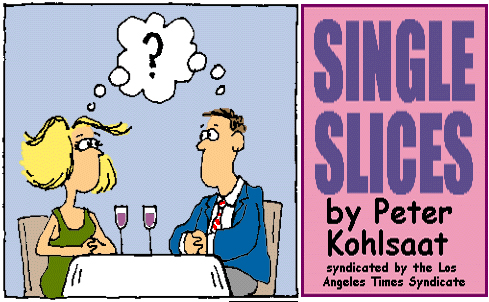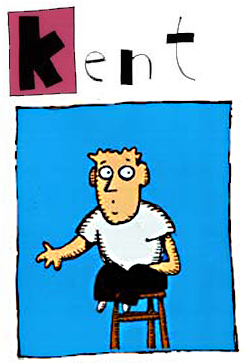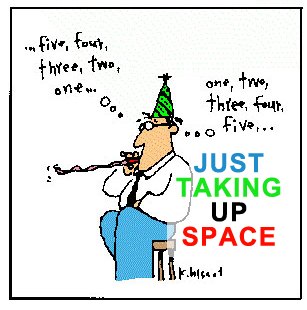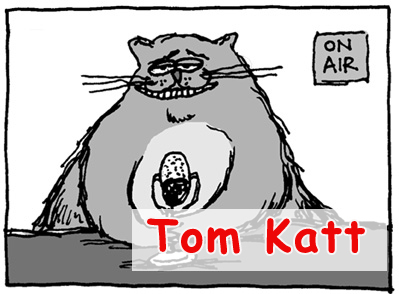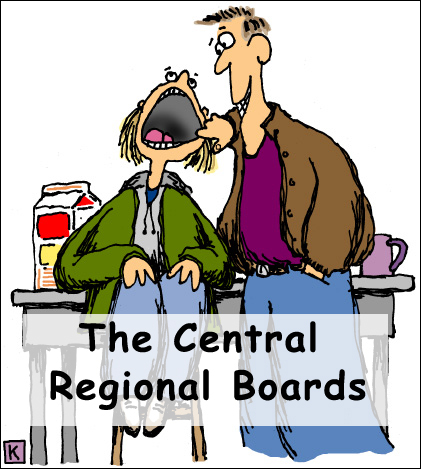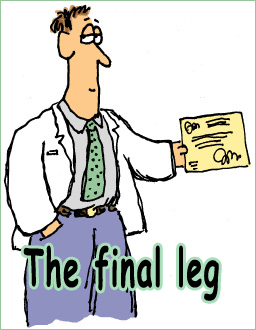 |
The Journey Back |  |
Part I
Monday, January 1, 2001
54/part II: "When lowering the floor of the mouth of a patient, a practitioner detaches all or part of which muscles?" WHOA! I think to myself. I have been away from dentistry entirely too long if practicing dentists are now lowering the floors of mouths. Actually, I have been out of dentistry for almost 15 years. The decision to leave dentistry was not a difficult one, but it seemed to have confounded almost everyone else. I simply chose cartooning over dentistry. The practice in Duluth was sold and I moved to Minneapolis. Six years of practcing dentistry and all I had to show for it was an empty bank account, a small house on the north shore of Lake Superior, and a 1973 carmine red TR6. Pretty much what I have now.
It was, however, a decision I have never once regretted. I have spent 15 glorious, self-absorbed years fishing America's fishing hot spots and bumming around the tropics. Just me and the dog in a beat-up Chevy van.
Cartooning has given me this freedom. Since leaving dentistry I have illustrated magazines, newspapers, calendars, books, greeting cards, T-shirts, web sites, cocktail napkins, clocks, mobiles, walls, pool bottoms, bathroom stalls. I've cartooned for Playboy. I've had a couple nationally syndicated cartoon panels. It has been a long, circuitous route since my days as co-editor--with fellow dental student, Jeff Erickson--of Contact Points, the dental school newspaper. But after all these years I'm ready for another change. My cartooning career has reached a kind of plateau and dentistry seems a logical career choice. A mid-life crisis? GIMMEE STRUCTURE!!! MY LIFE LACKS STRUCTURE!!! I doubt it, but then aren't those people suffering such crises always the last to know?
Most people retire at the end of their career. I prefer to think I retired near the beginning. And now that I wish to come out of retirement I am finding the dental profession to be acting like a vindictive, scorned ex-spouse; making certain I sufficiently regret even having ever harbored the notion that there might possibly be a fulfilling life elsewhere. (Not that I have any first-hand experience with ex-spouses, mind you. At least ex-spouses of my own).
I have been away from the soothing confines of a dental operatory for such a length of time that in order to become relicensed the local state dental board is requiring me to retake the National Board Dental Examination Part II. They seem to be under the assumption that for an ex-dentist like myself some of the finer points of the profession may have perhaps become a tad foggy. And they are SO RIGHT, if the national board exam is a fair indication. Unfathomably, I seemed to have totally forgotten that the supraspinal analgesic activity of morphine is mediated primarily through its influence upon the Mu opioid receptor subtype. How embarrassing. Blotted also from my memory was the fact that dopamine is the deficient transmitter in Parkinson's disease. And can you believe I actually forgot which microbe was responsible for Black Hairy Tongue? Alas, there is much information to reclaim before I am to be deemed adequately prepared to again practice dentistry.
In any case, no use groveling. What must be done, must be done. So for seventy-five bucks I have purchased some copies of past dental board exams and an amazing second-hand collection of 1200 color-coded flash cards and I am sallying forth to prepare. FORESOOTH, I say, RELEASE THE HOUNDS!
After having received from the American Student Dental Association a copy of the 1993 exam, (and a list of suggested reference texts—a tidy 130), I immediately sequestered myself on the back porch to determine the extent of my memory loss. I was tempted to pour myself a beer as I would in sitting down to grapple with the Sunday New York Times crossword, but refrained. This was Serious Business. Through the birch trees peeked the comforting blue of Lake Superior. Hummingbirds came and went from the feeder. Four-hundred questions. I scored 43%. On the case studies, I did better—63%. What constituted a legitimate passing score, I had no idea, but suspected future forays would need to be reinforced.
For three hours I was more or less entertained. It was not surprising how much had been forgotten that was once second nature. After all, my pea-sized head contains only so much gray matter and for the last decade or so most of the memory space has been taken up by information fully needed in outwitting smallmouth bass, avoiding moray eels, staying out of Mexican jails, and finding humor in the least obvious places.
Then, astonishingly, almost imperceptibly, scrap information began to percolate to the front of my brain, shaken loose from their dankest, most remote nether regions. Held fast there all these years, no doubt, by van der Waal's forces. Evidence of a former life became mysteriously apparent: a touch of anesthetic to the lingual nerve to augment an inferior mandibular nerve block, searching for a forth canal on a maxillary first molar (51% of the time!), formocresol pulpotomies on squirming six-year olds.
Some of the questions, however, I found more entertaining than others. I loved the ones with the arbitrary/subjective answers like: "Which of the following is the MOST convenient method for examining an 18-month-old child?" I didn't know there was a convenient way. I just assumed any way possible was good enough. Or: "While the dentist is preparing a large carious lesion in Tooth #30 for a restoration, a pulp exposure occurs. The patient angrily shouts at the dentist, 'You incompetent creep—you're responsible for this problem!' Of the following possible responses the dentist could make, which one is the most emphatic?" As often was the case, my response was not among the available answers. I expected an eventual practical question such as: "You receive a call from an attorney. 'I am calling on the behalf of my client, Bob Bobster, on whom you recently performed a root canal on tooth number 13.' Which of the following responses will LEAST likely get you in deeper dodo?" But it never appeared.
I also enjoyed the questions that required dentists to be physicians. "Thiazides, which are used in the treatment of hypertension, may require supplemental administration of which mineral: sodium, chloride, calcium, or potassium?" "What is the relationship between growth curves for lymphoid tissues and sexual characteristics?" Even though it's getting harder and harder to discern these days. Then there were questions that I am certain were included simply for the amusement of the exam contributors such as: "Which of the following systems (C-1 esterase, C-1q inhibitor, CH50 consumption, serine phosphatase, or complement synthetase) is thought to malfunction in the hereditary form of angioneurotic edema?"
And finally there were the just plain goofy questions: "A tablespoon contains how many ml?" "What is the mode of the following date set? 1, 1, 1, 1, 2, 2, 3, 3, 7, 9 (n=10; sum=30)"
Seeing what I was up against I decided I needed a study plan. Retaking the sample exam and methodically looking up all the answers, correct as well as incorrect, I figured would be an efficient method of reintroducing me to dental trivia. An adequate number of textbooks were secured and I immersed myself. Between fulfilling my cartooning obligations and wading local area rivers fishing for smallmouth bass, afternoon upon afternoon was spent on my screened-in porch researching obscure sarcomas, enzymatic deficiencies, cranial nerve enervation, and muscle attachment locations. I reacquainted myself with basic operative, endo, prosth, and oral surgery procedures. I was often reminded why ortho had never been part of my dental repertoire and why patients with TMJ problems were quickly referred. Over and over again I compared radiographs of adenoameloblastomas, granulofibromas, traumatic cysts, hyperparathyroidism. I cringed at a lot of pictures of ugly tongues, ulcerated mucosa, and deformed faces with blacked-out eyes. I began to wish people like Sjogren, Epstein, Barr, Papillon, Lefevre, Peutz, Jeghrs, Mikulcz, Frey, Melkersson, Treacher had never been born. I spent hours on the Internet at my favorite pharmaceutical information web site,
(www.nursespdr.com/members/database/ index.html) memorizing the uses, classifications, drug interactions, contraindications, side effects, and special concerns of drugs I know I'll never prescribe. Needing to know about the drug most often prescribed for gout, however, was only clogging up precious memory pathways. If all this information could be so easily referenced from my home computer, I reasoned, why must it be rote knowledge. Surely every modern dental office is wired to the Internet.
Microbes had begun to narcotize me. Porphyromonas gingivalis (formerly Bactreroides gingivalis). Camphylobacter rectus (formerly Wolinella recta). Provetella intermedia (formerly Bacteroides intermedia). Actinobacillus antinomycetemcomatosa. Fusobacterium adnauseam. Gram-positive rods and cones. Gram-negative anaerobics.
I was flabbergasted: did I really ever know any of this stuff? Did it ever once come up in conversation? Maybe this is what periodontists talk about when they are waiting for the group ahead of them to tee off. I can only imagine.
The test was harshly, unmercifully scrutinized. To be sure, an exam of 400 questions put before a panel of dental theorists would generate some lively debate, but what's a poor dental student supposed to do when confronted with conflicting "correct" answers? One question asked: "Which of the following is NOT part of the initial periodontal treatment plan? Root planing, surgical pocket elimination, home-care instruction, occlusal adjustment, or extractions of hopeless teeth?" The given answer was surgical pocket elimination. But according to Glickman's, Clinical Periodontology, one of the suggested reference textbooks: p854—"Occlusion is usually adjusted after gingival inflammation and periodontal pockets have been eliminated." Glickman then offers two convincing reasons in explanation.
There were also a number of inconsistencies. There was a question that asked for the microbes that "…have been implicated as periodontal pathogens" and a couple pages later a question that begins, "Although no causal relationships between particular bacteria and periodontal diseases have been determined…" What's a test-taker supposed to think of this?
My hopes were momentarily buoyed when I discovered a big black "ITEM NOT SCORED" ink-stamped diagonally across a question referring to a condition indicated by an accompanying photomicrograph. Granted, photomicrographs are cool, and all, but a FAMILIARIZATION WITH PHOTOMICROSCOPY, ESPECIALLY ELECTRONPHOTOMICROSCOPY, SHOULD NOT BE A REQUIREMENT TO PRACTICE DENTISTRY! Whew.
The 1993 ASDA sample test thus parsed, annotated, digested, and put aside, I set out to memorize a shoebox full of indexed flash cards (opportunistically published to the justifiably paranoid by Dental Decks, Inc. of New Jersey). This portion of my study strategy included no textbooks. I spent my idle hours kicked back on the porch in my easy chair, which the dog selflessly relinquished for our eventual mutual betterment, sifting through card after card after card of riveting dental minutiae. O, brethren Sisyphus.
This is how I spent the summer of 2000.

